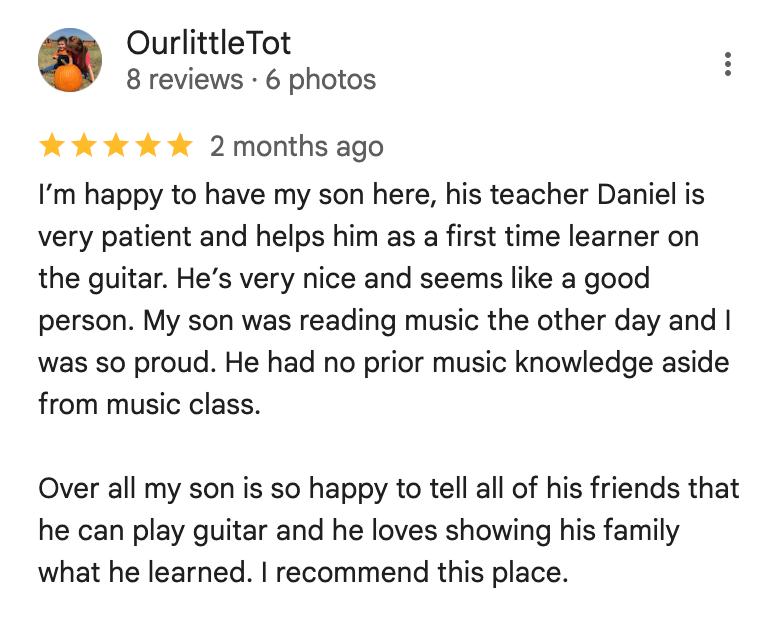🌟 Beginner Guitar Lessons: Your Complete Guide to Starting Guitar in Kingwood, TX
- Ines Scudellari
- May 19
- 4 min read
Updated: Aug 25

Starting guitar lessons is one of the most exciting adventures you can take — whether you're a child, teen, or adult. At Kingwood Arts Academy of Music in Kingwood, Texas, we specialize in helping complete beginners turn that first spark of curiosity into a fun, rewarding lifelong passion.
This complete guide will answer all your beginner guitar questions: from what to learn first and how many lessons you need to choosing the right guitar and finding a teacher near you.
⸻
🎵 Why start guitar lessons?
The guitar is one of the most versatile instruments in the world. It can adapt to any style — pop, rock, folk, jazz, country, and more. For beginners, it offers:
• Quick wins: You can learn a few chords and start playing songs faster than with most instruments.
• Portability: You can take it anywhere and play alone or with friends.
• Versatility: Use it for solo playing, songwriting, or as accompaniment.
• Creative expression: It's a great way to share emotions and tell stories.
🎸 What type of guitar should you start with?
One of the first big questions is: "Should I start with an acoustic or electric guitar?"
Acoustic guitar
• Great for singer-songwriters and folk or pop music.
• Builds finger strength and calluses early on.
• No need for an amp — just pick up and play.
• Usually lighter to carry around.
Electric guitar
• Strings are easier to press, making them more comfortable for many beginners.
• Ideal for rock, blues, jazz, and more modern styles.
• Requires an amplifier but opens up creative sound effects and tones.
• Typically has a slimmer neck, which some find easier to handle.
Your musical interests and comfort should guide your decision. We always recommend coming in to try different guitars before buying.
🟢 What should a beginner learn first?
Beginners should start with a foundation that builds confidence and enjoyment right away. At Kingwood Arts Academy, we usually begin with:
• Basic open chords (G, C, D, E minor, A minor)
• Simple strumming patterns
• Learning how to tune your guitar properly
• Easy songs to apply chords and strumming right away
• Rhythm basics and playing in time
As students progress, they can move into:
• Power chords and barre chords
• Fingerstyle techniques
• Improvisation and simple solos
• Reading chord charts and tabs
• Basic music theory to understand how songs are built
⸻
⏰ How many lessons does a beginner need?
This is one of the most common questions we get: "How many lessons does a beginner need before they can really play?"
While it depends on your goals and practice routine, here's a general idea:
• 3 months: Basic chords, simple songs, and comfortable strumming.
• 6 months: More chord shapes, smoother transitions, basic fingerpicking, or
simple solos.
• 12 months: Confident playing of full songs, barre chords, exploring different styles.
It's important to remember that learning guitar is a journey, not a race. Regular lessons and consistent home practice are the keys to growth and fun.
⸻
💡 Finding the right teacher near you
While YouTube and online tutorials are a great supplement, nothing replaces one-on-one instruction with a qualified teacher. Personalized feedback prevents bad habits and accelerates progress.
When choosing a teacher, look for:
• Experience with beginners of all ages
• Clear, encouraging communication style
• Flexibility to match your learning goals
• Structured lesson plans that stay fun and engaging
At Kingwood Arts Academy, our teachers create customized lesson plans that blend technique, theory, and the songs that excite you most.
⸻
🎯 Where can I take beginner guitar lessons near me?
If you live in or near Kingwood, Texas, you have an amazing local resource: Kingwood Arts
We offer:
• Private lessons tailored to your pace and interests
• Flexible scheduling options for kids, teens, and adults
• Opportunities to join group workshops and perform
• A supportive, welcoming community of musicians
Whether you're looking for classical, acoustic, or electric guitar, we'll help you discover your favorite style.
⸻
⚡ Practice tips for beginners
• Set realistic goals: Pick a song or riff to focus on each week.
• Daily short practices: 10–15 minutes every day beats one long session once a
week.
• Record yourself: Helps track progress and boost confidence.
• Join group jams or play with friends: Makes practice fun and motivating.
• Celebrate milestones: Share videos or play for the family to keep motivation high.
⸻
🏆 Common beginner challenges — and how to beat them
Finger pain
This is entirely normal in the first few weeks. With daily practice, your fingers will develop calluses, making playing much more comfortable.
Struggling with chord changes
Slow down and focus on accuracy before speed. Over time, your hands will remember the shapes automatically.
Keeping time
Use a metronome or play along with recordings. Internalizing rhythm takes time and patience.
💬 FAQs
Do I need to know how to read music?
No. Many guitarists start with chord charts and tabs. You can always learn to read music later if you choose.
Should I buy a cheap guitar to start?
Not necessarily — a very low-quality guitar can be harder to play and demotivating. We can help you choose a good-quality beginner guitar within your budget.
Am I too old to start?
Never! We have beginners from ages 5 to 75+. You're always welcome.
🌟 Ready to start your guitar journey?
There's no better time to begin. With the proper guidance, a supportive community, and your own
enthusiasm, you'll be amazed at how quickly you can make music.
_________________
What parents are saying:




Ready to start. Click HERE to request information.




Comments